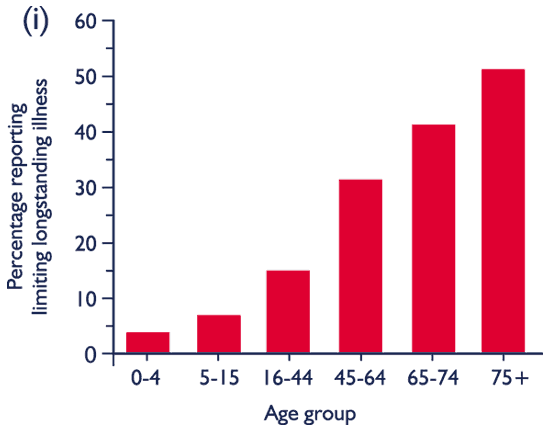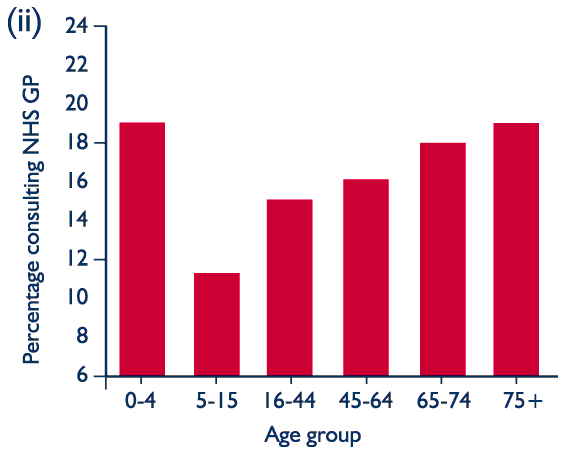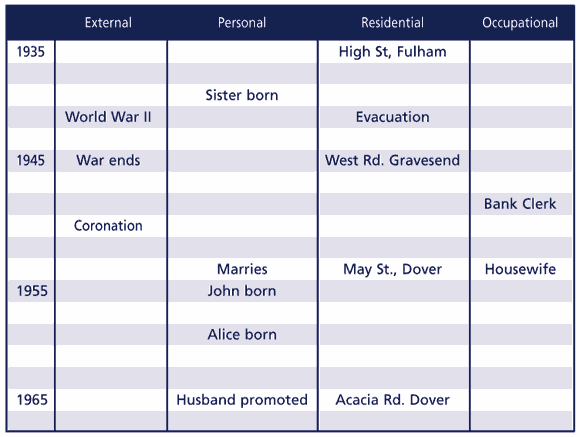 |
Close
window to return
|
Issue 3, January 1999, pp.8-9.
The lifegrid method
in health inequalities research
Paula Holland, Lee Berney, David Blane and George Davey Smith
The importance
of the lifecourse perspective
Explanations of why there are persisting socio-economic inequalities in
health have drawn attention to the importance of socio-economic differences
in people's living and working environments and in their health-related
behaviour. Recent research has highlighted how exposure to disadvantaged
environments and to health-damaging behaviours accumulate over the lifecourse,
from before birth, through childhood and across adulthood. Lifecourse
influences are increasingly seen to hold the key to understanding the
existence and persistence of socio-economic inequalities in adult morbidity
and mortality.(l)
While research is highlighting how disadvantage has cumulative effects
on health, few studies have examined the extent of social inequalities
in health amongst older people. This is despite the fact that older people
experience the highest rates of morbidity and make the greatest use of
health services (see Figure 1).
Figure 1: percentage of people i) reporting a limiting longstanding
illness, ii) consulting an NHS GP in the 14 days before interview, by
age: Great Britain, 1996


Source: ONS (1998) Living in Britain: Results from the 1996 General
Household Survey, London: The Stationery Office, Tables 8.1 and 8.19
Our study, 'Social Variations in Health in Early Old Age', attempts to
address this gap in health inequalities research. It examines the association
between cumulative exposure to health-damaging residential and occupational
environments through the lifecourse and socio-economic variations in physical
health of men and women in early old age. By early old age, the impact
of a lifetime's exposure to health insults is evident with chronic diseases
becoming manifest. We have collected information on lifetime influences
on health using the lifegrid method. Because the method provides an important
new approach to studying health inequalities, this article describes what
it is and what it can contribute to the understanding of health inequalities.
Alternative ways of collecting lifecourse information
One method of investigating lifecourse influences on health inequalities
is to use prospective data, such as that from the birth cohort studies,
designed to survey groups of individuals periodically from birth onwards.
However, while cohort studies provide invaluable data they have limitations.
Besides being expensive and subject to sample drop-out, introducing new
questions or measures is problematic, and none of the British birth cohorts
are yet old enough to examine health variations amongst older people.
An alternative is to use retrospective methods, where study members are
asked about events that happened previously in their lives. These methods
are often criticised as being unreliable and subject to recall bias. In
response to this criticism, the lifegrid interview method has been developed
to gather lifecourse information retrospectively and improve accuracy
of recall.
The lifegrid interview method
The lifegrid interview starts with interviewees providing a brief summary
of major life events such as leaving school, marriage, birth of children,
death of parents, moving residences and changing jobs. These events are
recorded on a series of time-lines - such as family, residential and occupational
- from birth to the present day. Figure 2 gives an example of a segment
of a completed lifegrid for a woman born in 1935. The completed lifegrid
allows the interviewer to structure the more detailed part of the interview
that follows, focusing on specific areas of interest, such as housing
and working conditions through the lifecourse. The accuracy of recalling
dates of life events is improved by cross-referencing events recorded
on the time-lines against each other and against an 'external' line of
relevant major public events, for example the Second World War and the
Coronation.
A validation study testing the lifegrid interview method was carried out
by two of the researchers working on the present study.(2) Socio-demographic
information collected retrospectively by lifegrid interview was compared
with archived records of the same information collected from the same
individuals 50 years previously. This information was recalled with a
useful degree of accuracy and inaccurate recall, where it occurred, was
not biased by social class or gender. Using data collected by the lifegrid
method allowed calculation of the number of years exposure to a range
of environmental factors known to be health-damaging and important in
the creation of social class differences in health. The validation study
found statistically significant social class differences in lifetime exposure
to these environmental hazards by early old age.(3)
Lifecourse influences on health inequalities
The present study makes further use of the lifegrid method. Lifegrid interviews
were carried out with a random sample of surviving members of a survey
of child health originally conducted in the 1930s. Between 1937 and 1939,
1,352 families living in 16 sites across Britain took part in a social,
dietary and clinical survey, carried out under the direction of Sir John
Boyd Orr at the Rowett Research Institute. Altogether 3,762 children were
surveyed and clinically examined.4 In 1997-98, we conducted interviews
with nearly 300 of these survey participants now aged 63-78.
Combining lifegrid interview data with information recorded in the archives
of the 1937-39 survey, our dataset includes details of childhood health
and social circumstances, personal, residential, occupational and smoking
histories and socio-economic circumstances through the lifecourse, from
childhood to the present day. Our results show that disadvantage accumulates
through the lifecourse; childhood disadvantage is associated with accumulating
and greater levels of lifetime exposure to health-damaging environmental
hazards. Lifetime hazard exposure is also associated with material and
health disadvantage in early old age (full results are forthcoming).
Figure 2: segment of a completed lifegrid for a woman born in 1935

The potential of
the lifegrid method
With adequate training, the method is easy to use. Recording data on the
lifegrid time-lines rather than longhand facilitates probing, as well
as allowing the interviewer to see at a glance the clustering of life
events. For example, episodes of poor health were often found to coincide
with stressful life events such as bereavement and retirement. As well
as improving accuracy of recall, we found that cross-referencing between
family, residential and occupational events improves interview rapport
and increases enjoyment for interviewees. Using information given by the
interviewee to frame further questions ("so if your son was born
in 1955 you would have moved to 3 Acacia Road when he was aged 10, around
the same time your husband was promoted. ..?") likens the interview
to an episode from 'This Is Your Life' according to one interviewee. Others
were surprised how much of their early lives they could remember, and
how accurately they could date events in their lives, with events on time-lines
corresponding with each other. Memories of the war years were especially
vivid and many of our interviewees had stories of disrupted education,
families torn apart through death or evacuation, and of both loving and
abusive host families.
Like any method, the lifegrid method has its limitations. Firstly, subjects
with very poor memories pose problems for researchers using any method.
For example, a traumatic childhood meant that one interviewee could remember
very little before his teen years. However, only 1% of our interviewees
had a memory so poor that the interview was difficult. Secondly, the length
of the recall period (from childhood to early old age) meant that lifetime
hazard exposure was calculated as the number of complete years exposure.
We found this was not sensitive enough to measure low lifetime exposure
to a hazard with high toxicity, for example, being exposed to the nuclear
testing at Christmas Island - a single exposure to a high dose of radiation.
Expressions of interest in the lifegrid method led to a training day held
earlier this year, providing both social scientists and medical researchers
with experience in its use. The lifegrid method has proved to be adaptable
to a variety of topics (from long-term precursors of childhood bowel disease
to social exclusion) and periods of recall (between 60 years to weekly
recall), illustrating the flexibility of the method. With the increasing
emphasis on public involvement in health needs assessment and the development
of local and national health strategies, the lifegrid method may have
broader policy-related uses. It provides a relatively low-cost way of
collecting information on health hazards within community settings.
The lifegrid method will never replace the need for birth cohort data.
However, the method will become increasingly useful as new questions emerge
about the antecedents of health in old age.
Paula Holland, Lee Berney and David Blane work in the Division of Neuroscience
at Imperial College of Science, Technology and Medicine, London University.
George Davey Smith is based in the Department of Social Medicine, University
of Bristol. This study 'Social Variations in Health in Early Old Age:
Investigation of Precursors in a 60 Year Follow-Up Study' ended September
1998 and full results are forthcoming.
References:
1. For example, Kuh, D. and Ben-Shlomo, Y. (eds.) (1997) A Lifecourse
Approach to Chronic Disease Epidemiology, Oxford : Oxford University
Press.
2. Berney, L. R. and Blane, D. (1997) 'Collecting retrospective data:
accuracy of recall after 50 years judged against historical records' Social
Science and Medicine, 45 pp.1519-1525.
3. Blane, D., Montgomery, S. M. and Berney, L. R. (1998) 'Research note:
social class differences in lifetime exposure to environmental hazards'
Sociology of Health and Illness, 20, 4 pp.532-536.
4. Gunnell, D. L., Frankel, S., Nanchahal, K., Braddon, F. E. M. and Davey
Smith, G. (1996) 'Lifecourse exposure and later disease: a follow-up study
based on a survey of family diet and health in pre-war Britain (1937-1939)'
Public Health, 110 pp.85-94.